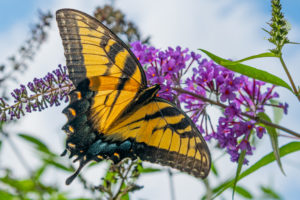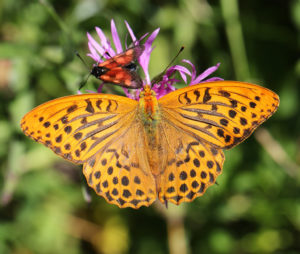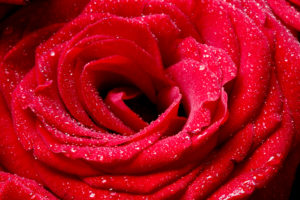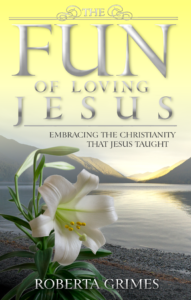The Lord is my shepherd. I lack nothing.
He makes me lie down in green pastures,
He leads me beside quiet waters, He refreshes my soul.
He guides me along the right paths for His name’s sake.
Even though I walk through the valley of the shadow of death,
I will fear no evil, for You are with me.
Your rod and Your staff, they comfort me.
You prepare a table before me in the presence of my enemies.
You anoint my head with oil; my cup overflows.
Surely Your goodness and love will follow me all the days of my life,
and I will dwell in the house of the Lord forever.
– David, Third King of Israel and Judah (c.1040 BCE – c.970 BCE), Psalm 23
 Until the advent of the radio, it was hard for the not-actually-dead to explain to the living where they were now. I recall when I was first doing afterlife research in the nineteen-seventies, and I came across a dead communicator soon after the turn of the twentieth century who had been among the first to have tried to explain to his living loved ones through a deep-trance medium where he was by using an analogy to the newfangled radio. He said something like, “You know how you can tune the radio to a higher station, and there’s music there too? Well, the same thing happens….” It struck me that his had been a brilliant insight!
Until the advent of the radio, it was hard for the not-actually-dead to explain to the living where they were now. I recall when I was first doing afterlife research in the nineteen-seventies, and I came across a dead communicator soon after the turn of the twentieth century who had been among the first to have tried to explain to his living loved ones through a deep-trance medium where he was by using an analogy to the newfangled radio. He said something like, “You know how you can tune the radio to a higher station, and there’s music there too? Well, the same thing happens….” It struck me that his had been a brilliant insight!
In fact, just as there is no time, so also apparently there is no space. For practical purposes, everything that exists is there in the room around you now. So when you die, you won’t be going far! When I used to give seminars, I would explain it by using television as an analogy. I would say that right now your mind is tuned to that body on this level of reality. When you die, your mind will simply tune to a slightly higher level of reality, where it will pick up a new, young body. At, I might add, a slightly higher channel, but in what is otherwise more or less the same place.
 That fog that we entered last week from your deathbed soon clears at a slightly higher vibration, and you find yourself in a reception garden. Although we ought to add that traveling awake from your deathbed in the company of your loved ones is by no means the only way to die.
That fog that we entered last week from your deathbed soon clears at a slightly higher vibration, and you find yourself in a reception garden. Although we ought to add that traveling awake from your deathbed in the company of your loved ones is by no means the only way to die.
There is a kind of triage that happens as the body dies, an extra assurance that we will get support if we need it. Or on the other hand, various things might briefly go wrong:
- When we die awake and in good health, we generally go directly to a reception garden. We’ll return to that discussion in a moment.
- When we die with physical or mental issues, we’ll go right to a specialized care facility. There are many such facilities on Level Three of the afterlife, and typically people who die with a physical or mental illness will need to spend some time being nurtured into a comfortable belief in their own good health. This generally takes three or four earth-months. And even people whose ill health may not have been apparent to the decedent’s loved ones may be nurtured briefly in a post-death care home out of an abundance of concern for them, so most mental mediums will suggest that we not try to connect with our recently-transitioned loved ones for the first few months after a death event.
- When we die in our sleep, we generally wake up in a Summerland home. My mother was desperately afraid to die. She flat refused to believe a word of The Fun of Dying, so eventually she transitioned in her sleep at the age of 93, and she woke up surrounded by loved ones in one of the homes in my Danish grandfather’s farm compound, which is high on a cliff above an astral sea.
- Some will simply go off-track for a time. According to our dear friend Mikey Morgan, who is a frequent Seek Reality guest, between a quarter and a third of those who die will go off-track at death initially, and mostly due to their own plain ignorance. Some will need to be rescued, perhaps by our dear friend Father Nathan, who is another frequent Seek Reality guest.
 So there are things that might go wrong, but let’s assume that you have sensibly followed your mother, your spirit guide, and your childhood pet. And soon the fog lifts to reveal a gorgeous scene!
So there are things that might go wrong, but let’s assume that you have sensibly followed your mother, your spirit guide, and your childhood pet. And soon the fog lifts to reveal a gorgeous scene!
Most of the descriptions that we have of the North American arrival gardens are from the first few decades of the twentieth century. And we have to assume that a lot has changed since then. Please understand the following facts:
- Colors in the Summerland go far beyond the visible light spectrum. Just try to imagine that! Actually, you can’t imagine it. The best you can do is to imagine some various shades of purplish-orange. But the grass and vegetation don’t need to be green, and the flowers are mostly in unbelievable colors. The sky, too, is going to be just about any shade but blue!
- There is no sun, and the ambient light is white, somewhat paler at Level Three but ever brighter as you go higher. There is no night, no season, no weather to speak of, although if you want weather experiences you can have them.
- The North American Summerland has snow-capped mountains in the distance. Don’t think of them as our Rockies especially, but imagine them more as a generic backdrop of mountains that will seem to be nearer or farther away, according to your preference. Bodies of water of varies sizes are around, and since travel is by mind you can travel as you like.
- Everything in the Summerland is human-created. That is true of what we see around us here, but it is much more playfully true of the Summerland. For example, the afterlife literature includes accounts of people learning how to create living plants, and also people watching as groups of elevated beings mind-create buildings together. Plans for those buildings are drawn and studied, and then the buildings shimmer into and out of existence before becoming solid.
- Everything in the Summerland seems alive-ish, somehow dimly aware, and giving off
 energy. Many things give off a dim music as well. All of this is true to such an extent that we don’t need to eat, since the plants and the water give off all the energy that we need to abundantly sustain us. The flowers turn their faces to us, and the vegetation caresses us as we pass. And, yes indeed, the water is alive. It caresses us, it feels like silk against our skin, and we can walk into it fully clothed and come out of it dry.
energy. Many things give off a dim music as well. All of this is true to such an extent that we don’t need to eat, since the plants and the water give off all the energy that we need to abundantly sustain us. The flowers turn their faces to us, and the vegetation caresses us as we pass. And, yes indeed, the water is alive. It caresses us, it feels like silk against our skin, and we can walk into it fully clothed and come out of it dry.
We cannot now know the precise details of the arrival gardens of 2052, or whenever you might make it there. But here is what I am betting you are going to see:
- Echoes of Your Youth and Childhood. Thomas Jefferson said when he spoke through Leslie Flint in 1960 that the Summerland when he first arrived looked as rural Virginia had looked when he was a boy.
- Your Childhood Pets, and also Birds, Butterflies, and Dragonflies. Many of those who have newly arrived and communicated with us from there have remarked about these lovely details.
- Splashing Fountains, Benches, Flowers, Walkways, and Graceful Trees. Many new arrivals have remarked about seeing gigantic flowers as tall as a man.
- People Dressed in Various Period Fashions. It doesn’t seem to matter how we dress. At higher levels people often wear spirit robes, or what are sometimes called astral robes, the sort of long-sleeved, floor-length belted tunics in shimmering pastel colors that angels are commonly assumed to wear. But in the Summerland levels, people typically wear whatever they wore in their most recent earth-lifetime.
- People Enjoying Single- or Double-Occupant Vehicles. Little cars, boats, and airplanes were being played with even early in the twentieth century, so lord only knows what they are doing now! And these vehicles are all powered by mind, so there is no exhaust.
- Our Astral Bodies Are Mind-Created. We may at first feel unaccustomed to mind-creating our
 bodies, but we soon become adept again at changing our appearance at will. This body that you have worn from your deathbed looks as you looked in your most recent earth-lifetime, but it is likely to be growing younger in appearance as you begin to think younger. Eventually you may even choose to look as you looked in a different earth-lifetime. When Thomas and I visited Jesus a few weeks ago, the Lord wanted to make me comfortable so He first made Himself look like a benign older guy. And then He looked like church-Jesus for the group who had come to receive His blessing; and then finally He became the young olive-skinned Jesus with curly hair that He seems to be experimenting with currently. It has of late been scientifically proven that He did indeed resurrect His body a couple of days after its death two thousand years ago. But even by those standards, I’ve got to say that I thought what I saw Him do a few weeks ago in wearing three different bodies successively also was pretty impressive!
bodies, but we soon become adept again at changing our appearance at will. This body that you have worn from your deathbed looks as you looked in your most recent earth-lifetime, but it is likely to be growing younger in appearance as you begin to think younger. Eventually you may even choose to look as you looked in a different earth-lifetime. When Thomas and I visited Jesus a few weeks ago, the Lord wanted to make me comfortable so He first made Himself look like a benign older guy. And then He looked like church-Jesus for the group who had come to receive His blessing; and then finally He became the young olive-skinned Jesus with curly hair that He seems to be experimenting with currently. It has of late been scientifically proven that He did indeed resurrect His body a couple of days after its death two thousand years ago. But even by those standards, I’ve got to say that I thought what I saw Him do a few weeks ago in wearing three different bodies successively also was pretty impressive!
At some point by now, you will have reunited with your vast, eternal mind. Suddenly you will feel freshly brilliant, and you will remember so many things! You will recall some favorite prior lifetimes, and recognize and greet some very old friends who perhaps are quietly coming to join you in this beautiful and colorful garden. So you will sit down with them on a bench for a while in this lovely and deeply quiet place. You never in memory have heard quiet like this, without even distant traffic sounds, no ringing in the ears, and only perhaps the gentle twitter of birds and the lilt of flowers, like barely audible laughter.
 Soon you and your primary guide will be moving on to experience your life-review in a great stone building. Then you and your friends and family will gather for your welcome-home party in your family’s ancestral home that could be in an astral city, perhaps; or, as mine is going to be, it might be held amid horses and cows on an old ethnic farm that overlooks the sea. But for now, you have the infinite peace of knowing that once again you are truly at home and forever safe in everlasting arms.
Soon you and your primary guide will be moving on to experience your life-review in a great stone building. Then you and your friends and family will gather for your welcome-home party in your family’s ancestral home that could be in an astral city, perhaps; or, as mine is going to be, it might be held amid horses and cows on an old ethnic farm that overlooks the sea. But for now, you have the infinite peace of knowing that once again you are truly at home and forever safe in everlasting arms.
And what does the Lord require of you?
To act justly, and to love mercy,
and to walk humbly with your God.
– Micah of Moresheth (c.737 BCE – c.696 BCE), from Micah 6:7-8











































